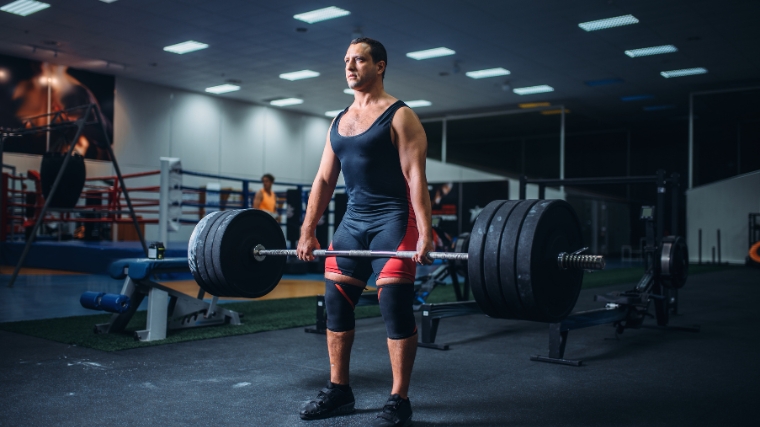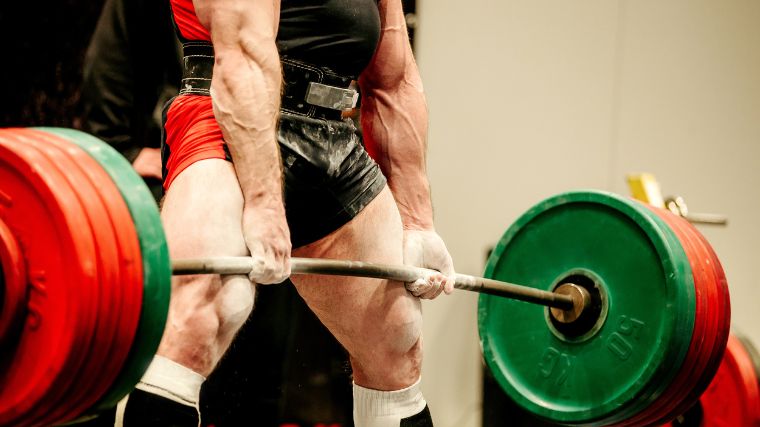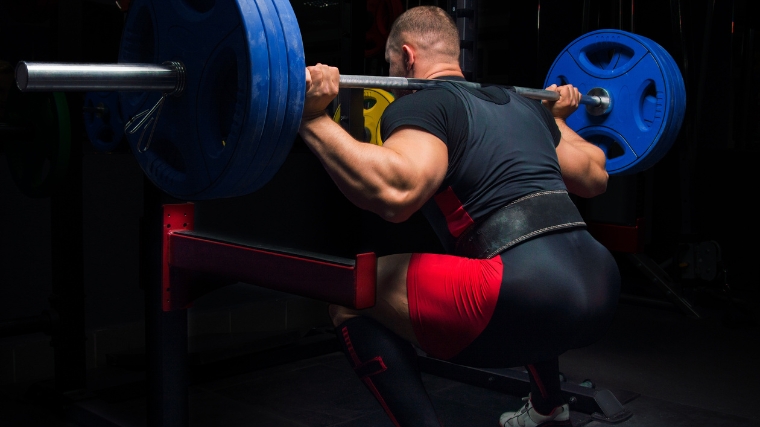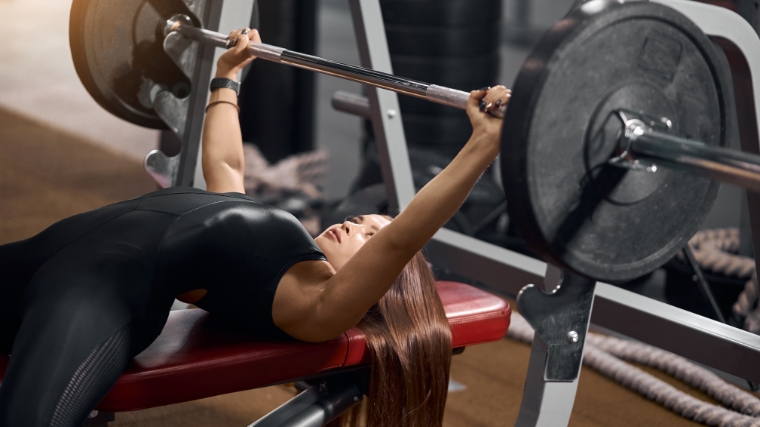It sounds silly at first, sure: When you think of work capacity, your mind calls forth images of sweat pouring down your face, your heart pounding in your chest, and the ominous, authoritative beeping of a stopwatch that signals it’s time to do another round of throws, or sprints, or whatevers.
If you hit the gym because you like working yourself to a pulp, those things might sound alluring. But — at first glance, at least — they’re the antithesis of powerlifting. The powerlifter pursues only an ever-heavier barbell; how long they can hold it or how many reps they can pump out are of no concern.

Or are they? While powerlifting may be a 1-rep-max-centric sport, your work capacity affects your strength performance in more ways than you might think, both in training and on meet day. To reach your maximum potential, you need an engine that can go the distance. Here’s how to gas up.
What Is Work Capacity?
Runners train their endurance. In CrossFit, you’ll often hear of an athlete having a good “engine.” Powerlifters need work capacity to get through their training sessions; all of these descriptors refer to the same general quality.
Work capacity is your ability to tolerate a specific amount of physical activity. More pointedly, you need the mental and physical fortitude to accrue enough work to elicit a response. For powerlifters, that response is gaining strength.

In the simplest terms, you need to perform a certain amount of resistance training to get stronger. Your work capacity refers to how well you can tolerate that training and how much you can get done before your tank is empty.
Muscular Work Capacity
Muscular work capacity is the first, and most literal, slice of the pie. After all, your muscles contract to move your joints while you bench press, squat, or deadlift. In order for your muscles to contract properly, they need adequate reserves of a whole host of different compounds and nutrients ranging from glucose to sodium.
As such, your ability to perform, say, a high-rep set of squats is contingent on proper nutritional habits and gradual exposure to higher-repetition training.
Cardiovascular Work Capacity
Powerlifting training falls somewhere between a marathon and a sprint. Your body’s cardiovascular system pumps blood to your muscles and recycles waste products like lactate during extended bouts of effort (think a five-rep-max set of pause squats).
Short, repeated bursts of movement with limited or inconsistent rest periods can also challenge your cardiovascular endurance. Think of the climate in the back room of a powerlifting meet; you may have to share a platform with several other athletes, load and unload the same barbell together, or jog over to another area to hit a warm-up attempt at a specific time.
If you’re used to training by yourself or have the luxury of abundant equipment or space in your gym, the sometimes-hectic atmosphere of competition might have you huffing and puffing if you’re not prepared for it.
Mental Work Capacity
Your most precious resource during high-intensity powerlifting training is your mind. You might scoff at that idea at first, but cognitive sharpness and mental acumen have a strong impact on your success — or failure — in strength sports.
Your brain and central nervous system share the same “resources” with regard to task execution, regardless of setting. If you’ve ever hit the gym after a long, grueling day in the office, you know how difficult it can be to get your head in the game to lift heavy.
Mental work capacity is mainly about preserving mental alertness. If your mind isn’t clouded or preoccupied, you’ll be able to visualize clearly, react faster, and coordinate yourself better with the barbell. (1)
Why You Need Work Capacity for Powerlifting
Your work capacity is a multifaceted and nuanced aspect of your performance as a powerlifter. It’s something that you might take for granted if you have it, but you’ll definitely notice when you don’t. Your engine will run differently in training and competitive settings as well; here’s how.
In Training
Powerlifting training may broadly revolve around increasing 1-rep-max strength, but almost all powerlifting programs are constructed with multiple different athletic qualities in mind.
Almost all well-designed programs start by helping you build up your base, or work capacity, via an “accumulation cycle.” This block of training typically involves gradually upping your total volume over the course of several weeks so you have a large reserve of endurance to use going forward.

As a bonus, these accumulation cycles also help you put on some muscle mass. Training volume is a significant driver of hypertrophy to begin with, and on top of that, some research has shown that combining strength and endurance-focused training leads to more overall growth than opting for just one. (2)
In Competition
Work capacity — the physiological sort — is a tremendous asset to have during long training blocks. But come meet day, your ability to withstand high amounts of volume isn’t a relevant skill. All that matters on the platform is how much you can lift over the course of nine attempts.
As such, powerlifting programs tend to taper down in volume as a max-out day approaches. This reduces your work capacity, but also flushes out accumulated fatigue and lets you zero in on maximal strength exclusively. (3)
In a competitive setting, your work capacity needs are almost entirely practical. You need to be able to smoothly move through your warm-up attempts (especially if sharing a barbell with other athletes), adjust to environmental changes without throwing your mental game off-balance, and manage the pressure of performing in front of an audience.
How to Increase Work Capacity for Powerlifting
If you’re about to embark on a new phase of powerlifting training, your first order of business should be to build up your work capacity. This will enable you to pile on heaps of meaningful, high-value training without burning out or needing frequent deloads.
Up Your Volume, Slowly
There’s no secret technique behind developing your work capacity for powerlifting. The general idea is actually very simple: Gradually perform more work. “Gradual” is the important bit, though.
There’s a fine line between applying the right amount of stimulus to elicit an adaptation and pushing things too far. If you’re used to performing, say, 10 to 12 working sets in a given session and you abruptly jump to 30, you’re probably doing more harm than good.

Research shows that slowly increasing the amount of work you perform will return more endurance-based adaptations, both in terms of the number of sets you do and the number of reps in each set. (4) This is something you’ll want to accomplish over the course of several pre-planned weeks, though, not dive headfirst into.
Reduce Your Rest Times
You can’t pack in training volume indefinitely. Every lifter has a ceiling to the amount of work they can reasonably recover from. There are also diminishing returns to consider; you don’t need the work capacity of a professional distance runner to make it through a high-volume powerlifting cycle.
So, instead of building up your endurance via higher training volumes, you can instead aim to increase the density of your workouts. Reducing the amount of time you rest between sets will challenge your cardiovascular system and mental coordination. As a side perk, it’ll also save you time in the gym.
Periodize It
You can jump into the gym with the vague goal of, “do more” and probably make decent progress on your work capacity. However, no good powerlifter leaves gains to chance. A structured, periodized approach to accumulating endurance will ensure you grow your engine without risking injury, burnout, or needing a training break.
Sample Periodization for Work Capacity
Here’s a sample six-week training scheme for building your work capacity in the back squat. Almost all powerlifters squat more than once a week, but this should give you a very general idea of how accumulating meaningful volume might look.
- Week 1: 3 x 5 (15 reps total)
- Week 2: 4 x 5 (20 reps total)
- Week 3: 4 x 3 (12 reps total, deload)
- Week 4: 5 x 4 (20 reps total)
- Week 5: 6 x 4 (24 reps total)
- Week 6: 6 x 5 (30 reps total)
The total number of reps performed within a given bracket of time is, generally, the best barometer of work capacity. If you can analyze your own training and confirm that you’re performing more sets, or more overall reps, than two weeks prior, your work capacity is rising. Milk these gains for, say, 4 to 8 weeks and you’ll have set yourself up for some stellar heavy training to follow.
Choose Conditioning Wisely
As a powerlifter, you partake in a relatively narrow sport consisting of only three barbell-based exercises. However, you shouldn’t chuck all your eggs into that basket. You can certainly build up your work capacity through the bench press, back squat, and deadlift (specificity is king, after all), but you shouldn’t be afraid to mix in some cardiovascular conditioning as well.
Conditioning workouts are a two-for-one; you can bolster your cardio and get away from the barbell a bit for some much-needed novelty. However, not all forms of endurance training are of equal value.
For example, some literature has shown that concurrent training — that is, training for multiple athletic qualities simultaneously — can be an asset or a detriment depending on the type of exercise you do. (5)
High-impact cardio like running or plyometrics may dampen your muscle or strength gains. (5) Low-impact cardio, like swimming or cycling, may be a wiser investment if you’re already putting your joints through the ringer during your powerlifting workouts.
Steady-State Cardio vs. HIIT
Contrary to the prevailing narrative, both steady-state cardio training and high-intensity interval training (HIIT) seem to provide a comparable return on investment if you want to improve things like your VO2 max (a key marker of endurance capability). (6)
Some data note that enjoyment tends to wane over the course of extended cardio training plans, so you should probably pick whichever modality is most fun for you. That said, from a practical perspective, interval training resembles the cardiovascular demands of powerlifting a bit better than hitting the elliptical for 20 minutes straight.
Your Takeaways
Powerlifting is a strength sport that relies, partially, on having a good amount of work capacity. Your work capacity — the amount of exercise you can tolerate, usually on a workout-to-workout basis — enables you to complete difficult training and perform well in a competitive environment.
- Work capacity is multifaceted; muscular, cardiovascular, and mental capacities are interlinked but operate through separate mechanisms.
- In training, work capacity allows you to successfully navigate periods of high volume or intensity.
- In competition, you need the work capacity to adapt to environmental changes or perform warm-up reps in quick succession.
- The best way to increase your work capacity for powerlifting is to gradually increase the amount of volume you perform.
- A small amount of general conditioning work is also wise, but make sure you pick the modality that is most fun and sustainable for you.
The Limit Does Not Exist
Bruce Lee didn’t fear the man who practiced 10,000 kicks once — he feared the man who practiced the same kick 10,000 times. That idea holds true in any sport, especially powerlifting. If you want to reach your true potential with the barbell, you have to practice with it. Often.
But practice takes time and, more importantly, energy. You need the work capacity to sustain the training that pays dividends on the competition platform. Work on your work capacity, and you’ll find your limits evaporating into thin air.
References
- Blankert, T., & Hamstra, M. R. (2017). Imagining Success: Multiple Achievement Goals and the Effectiveness of Imagery. Basic and applied social psychology, 39(1), 60–67.
- Küüsmaa, M., Schumann, M., Sedliak, M., Kraemer, W. J., Newton, R. U., Malinen, J. P., Nyman, K., Häkkinen, A., & Häkkinen, K. (2016). Effects of morning versus evening combined strength and endurance training on physical performance, muscle hypertrophy, and serum hormone concentrations. Applied physiology, nutrition, and metabolism = Physiologie appliquee, nutrition et metabolisme, 41(12), 1285–1294.
- Travis SK, Mujika I, Gentles JA, Stone MH, Bazyler CD. Tapering and Peaking Maximal Strength for Powerlifting Performance: A Review. Sports. 2020; 8(9):125.
- Schoenfeld, B. J., Grgic, J., Van Every, D. W., & Plotkin, D. L. (2021). Loading Recommendations for Muscle Strength, Hypertrophy, and Local Endurance: A Re-Examination of the Repetition Continuum. Sports (Basel, Switzerland), 9(2), 32.
- Wilson, J. M., Marin, P. J., Rhea, M. R., Wilson, S. M., Loenneke, J. P., & Anderson, J. C. (2012). Concurrent training: a meta-analysis examining interference of aerobic and resistance exercises. Journal of strength and conditioning research, 26(8), 2293–2307.
- Foster, C., Farland, C. V., Guidotti, F., Harbin, M., Roberts, B., Schuette, J., Tuuri, A., Doberstein, S. T., & Porcari, J. P. (2015). The Effects of High Intensity Interval Training vs Steady State Training on Aerobic and Anaerobic Capacity. Journal of sports science & medicine, 14(4), 747–755.
Featured Image: Nomad_Soul / Shutterstock